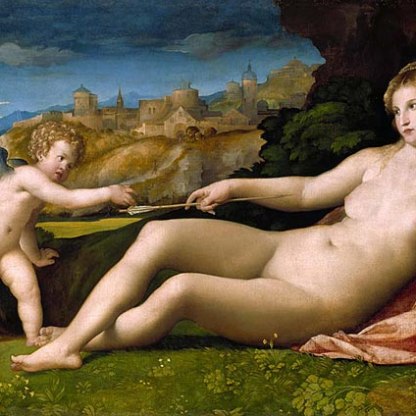A Girl with a Mirror

With its wide variety of textures, this painting by the Utrecht artist Paulus Moreelse appeals strongly to the sense of touch. The velvet of the table-cloth, the blue and yellow satin of the girl’s dress, the pink and white cotton of her blouse, her blonde hair with its floral decoration, and her soft pale flesh: almost every surface suggests rich, sensual feeling.
The girl’s bare neck and chest are presumably about to be, or have just recently been, adorned by the gold chains and string of pearls that shimmer on the table in front of her. Now her flesh is provocatively exposed – her entire breast is visible, while her mirror image, detail right, has only the vaguest suggestion of clothes.
She points at her own reflection in the mirror while she smiles at the viewer, inviting us perhaps to share in the enjoyment she gets from contemplating her own youth and beauty. The mirror is a common symbol in paintings that deal with human vanity, and some critics have called this work An Allegory of Vanity.
Before the girl lies an open book with an illustration of an old woman kneeling before an image of the goddess Venus. Beneath is written a Latin caption which translates as ‘The desire of the flesh [lascivia] does not live for itself but for Venus. To her she offers gold and jewels and all riches.’ Some critics, therefore, have described the girl as ‘a modern Venus’ or a personification of Lascivia.
The picture on the back wall shows an episode from Ovid’s Metamorphoses, in which the lust-driven nymph Salmacis forces herself upon the beautiful youth Hermaphroditus.
This single canvas, therefore, bears several different images: the mythical painting, the illustration in the book, the reflection of the girl in the mirror and of course the portrait itself. All of them deal with female sexuality.
In a strict Christian society like seventeenth-century Utrecht, this attractive, flirtatious young woman would have been open to condemnation. Aernt van Buchel, a close friend of the artist, in the 1620s wrote a poem entitled ‘On the painting of lascivious Vanitas made by P. Moreelse’:
This is the image of the vain World, and the triumph of the flesh,
Where the greedy, rapacious demon always holds sway.
Riches is busy with Venus, evil Furor [Frenzy] with love;
Both are in a blind rage, both do not know measure.
Let these be the antidote and cure for immoral sorrow: Fasting, tears, or better: contrition over evil.
It is not clear which particular work by Moreelse these joyless verses describe, but there is nothing in the Fitzwilliam painting which directly bids us to draw such a stern Calvinist message from it.
The image in the background shows precisely the kind of erotic pagan myth that discerning European patrons had enjoyed since the fifteenth century. Indeed, with its bosky background and the subject of a blonde woman embracing a man, it closely resembles a painting by Moreelse of Venus and Adonis – another of Ovid’s Metamorphoses in which a woman intitiates a sexual encounter. Would Moreelse make reference to one of his own pictures if his intention had been to wholeheartedly condemn the subject of this painting?
Moreelse’s girl may be vain, but he has painted her with affection. As an artist he was at the forefront of the development of pastoral painting in the Netherlands – enjoyable, romantic images that celebrated the love-lives of shepherds and shepherdesses in a mythical Golden Age. He used the same model as he does here in a painting of one of these amorous rustics. And as the father of ten children, Moreelse himself was clearly not entirely averse to the pleasures of the flesh.
Themes and periods
Data from our collections database
? Elizabeth, Queen of Bohemia; Earls of Craven, sold Sotheby's, 27 November 1968, lot 103, repr., bt. Agnew's for the Museum
Legal notes
Bought from the Duplicate Paintings fund, with a contribution from the Friends of the Fitzwilliam.
Acquisition and important dates
- Method of acquisition: Bought
- Dates: 1968
Dating
- 1620s
- Production date: AD 1627
Maker(s)
- Moreelse, Paulus Painter
Materials used in production
Read more about this recordStories, Contexts and Themes
Other highlight objects you might like
Suggested Curating Cambridge products
Sign up to our emails
Be the first to hear about our news, exhibitions, events and more…







